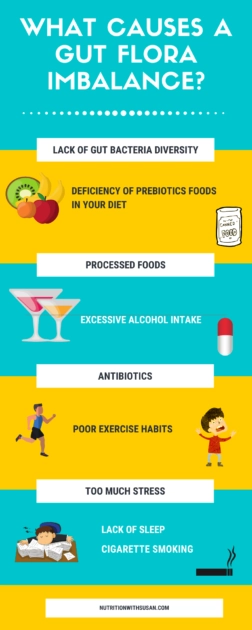Introduction
Until recently, the various systems of the body were thought to function independently on their own with no connection whatsoever.
Now we realize that what happens in one area of the body such as the gut, may have a huge impact on another part of the body — like your joints.
No part of the body is an island unto itself. Every part works together to function as a whole. If one part is malfunctioning, it may have a drastic effect somewhere else.
For example, the health of the gut microbiome may have a huge impact on the immune system. If dysbiosis occurs, it may signal the start of an autoimmune disease such as rheumatoid arthritis.
But what is the gut microbiome, anyway? Read on and find out.
What is the Gut Microbiome?
Trillions of viruses, bacteria, fungi and other microbes make up what is known as the microbiome. The majority of these tiny organisms reside in your intestines and on your skin.
The cecum of the large intestine contains the most microbes making up the “gut microbiome.” Someone once said we humans are more bacteria than human cells.
How true! The human body is made up of about 10 trillion human cells along with 100 trillion bacterial cells.
Almost all gut bacteria fall into four groups — Bacteroidetes, Firmicutes, Actinobacteria, and Proteobacteria. Each group has its own job to do and requires different nutrients to grow and function.
Take Bacteroidetes — it’s one of the good guys as it fights inflammation and even helps you fit into those skinny jeans.
Conversely, Firmicutes is considered one of the bad guys since it may contribute to obesity and diabetes.
When the gut has an oversupply of harmful bacteria, an imbalance may occur which is known as dysbiosis. Dysbiosis has been linked to inflammation, weight gain, insulin resistance and colon cancer.
Not all bacteria are bad however. Some are actually beneficial to the body and it’s systems. There is a growing body of evidence the microbiome may affect the immune system and brain health.
The gut and brain are formed from the same fetal tissue. Think about it — the intestines even look a little like the brain!
It’s super important to keep your friendly gut bacteria healthy and happy. But what causes a gut flora imbalance in the first place?
What Causes a Gut Flora Imbalance?
A lack of diversity for one. Poor gut bacterial diversity makes it hard to recover from those nasty assaults to your body from antibiotics and infections. Too much bad bacteria is definitely not a good thing!
A deficiency of prebiotic foods in the diet. What are prebiotics? Prebiotics are a type of fiber found in certain fruits, vegetables, and whole grains that help promote friendly bacteria growth.
Processed, inflammatory foods. The Standard American Diet (SAD) is loaded with overly processed foods like refined carbohydrates and industrial seed oils that can lead to gut issues.
The SAD diet promotes inflammation and decreases microbial diversity in the gut, leading to a whole host of chronic diseases.
Excessive alcohol intake. Chronic high alcohol consumption may lead to dysbiosis. If you drink, do so in moderation.
Studies have shown that moderate red wine consumption may actually increase good gut bacteria while decreasing the bad — this effect may be related to plant compounds known as polyphenols found in red wine.
Antibiotics. While antibiotics are important in the treatment of certain bacterial diseases and infections, they kill all bacteria — the good and the bad!
In the short term, antibiotics can lead to a decline in beneficial bacteria such as Lactobacilli and an increase in bad bacteria like Clostridium. In the long term, they may reduce that diversity of gut flora.
No exercise. Recent studies show that regular exercise may improve gut health. Any kind of physical activity can help increase your levels of good bacteria like Bifidobacterium and Akkermansia. Just move!
Too much stress. Never a good thing, especially for the gut, where excessive stress can decrease bacterial diversity and increase the number of bad bacteria.
Too little sleep. Sleep is regulated by the body’s own internal clock or circadian rhythm. The gut follows a similar internal clock; therefore, sleep deprivation disrupts this internal rhythm, leading to unwelcome changes to the gut flora.
Just 2 nights of poor sleep can increase the bacteria associated with obesity and type II diabetes.
Smoking. Smoking is harmful to almost every organ of the body. Smoking cessation was found to improve gut flora diversity, thus improving overall gut health.

Can You Heal Your Gut Naturally?
Yes, fortunately, this is figureouttable! There are a lot of things you can do to heal your gut without spending a ton of money.
Eliminate Processed Foods
One simple thing you can do is kick all your processed foods to the curb. Choose whole foods that are naturally anti-inflammatory instead.
Fresh fruits and veggies, grass-fed beef, wild-caught fish are good choices; anything processed with ingredients you can’t pronounce is not.
You may want to try an elimination diet if you suspect certain foods like gluten or dairy are causing you problems. Testing for food intolerances may also help identify specific foods that are causing you inflammation.
Add Fermented Foods and Foods High In Fermentable Fiber
Foods with fermentable fibers help increase good bacteria in your gut and promote healing. Good sources are onions, garlic, artichokes, beans, and legumes.
Fermented food like sauerkraut, kimchi, kombucha, kefir, and yogurt help restore the gut microbiome as they are naturally abundant in probiotics.
Get More Sleep
Improving the quality of your sleep is incredibly important for maintaining a healthy gut.
Some inexpensive sleep hacks:
- Go to bed at the same time every night (including weekends!)
- Take the TV, computer, iPad, and phone out of the bedroom. Blue light from electronics is incredibly disruptive for sleep so keep it out of there if you can.
- Keep the temperature in your bedroom around a cool 68 degrees as this has been found to be the optimum temperature for sleeping.
- Light pollution impacts your sleep so make sure your bedroom is nice and dark.
- Keep all activities other than sleeping and making love out of the bedroom. No phone calls, social media, email, etc. Do these things someplace else.
Exercise
Do some type of exercise you enjoy so you’ll stick with it. You don’t need to go to the gym — run, walk, jump, bike, whatever makes you want to get out there and move your body!
Regular exercise helps keep your microbiome in shape as well as your body. Don’t skimp on it!
De-Stress
Stress can have a negative impact on your microbiome. Try adding a few relaxation practices like yoga, meditation, and mindfulness to your daily routine.
You know there’s an app for it. Apps like Calm or Headspace can guide you if you’re a meditation newbie. I’ve used both and found them really helpful.
Is There a Gut Microbiome and Rheumatoid Arthritis Connection?
Maybe…
Several studies have found a link between gut microbial diversity and dysbiosis in patients with RA. However, it’s difficult to determine if RA is the cause of dysbiosis or dysbiosis is the cause of RA!
In a recent study, researchers identified a type of bacteria in the gut, Prevotella copri (P copri), present in 75% of people tested with new onset, untreated rheumatoid arthritis (RA).
It was also present in 12% of those tested with chronic treated RA, 38% of people with psoriatic arthritis, and 21% of the control group.
Good bacteria like Bacteroides were found in lower amounts in those with higher levels of Prevotella. Mice studies appear to show a correlation between P. copri and inflammation but more research is needed.
A 2016 study found that a different strain of bacteria, Prevotella histicola, may actually decrease RA symptoms and disease progression. Sounds too good to be true, right? The study’s authors say more research is needed to confirm this theory.
In the future, it may be possible to treat rheumatoid arthritis by tweaking the microbiome. While there aren’t many ongoing human studies, there are some animal studies that look positive.
A 2013 rat study in The Journal of Interferon and Cytokine Research showed that the bacteria Lactobacillus casei and Lactobacillus acidophilus, both commonly found in yogurt, reduced joint inflammation better than NSAIDS.
The day we can treat RA by taking a probiotic is still a ways off, but definitely on the horizon. The search continues for that special gut bacteria that alleviates joint pain, swelling, and inflammation.
CONCLUSION
This area of study sounds very promising. The research so far seems to show a connection between the microbiome and rheumatoid arthritis.
Maintaining a healthy, diverse microbiome may be one of the smartest things you can do to prevent many of the most common chronic diseases, including RA.
Making a few simple diet and lifestyle changes is a small price to pay for a healthy gut. A healthy gut equals a healthy life. Feed it right and it will treat you right.


